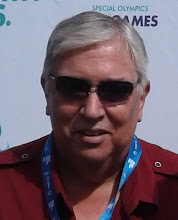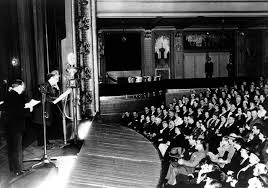"I Forgot to Mention That the Band Was Here"
A collector of classic radio inevitably trips upon a generous helping of classic music. Classic radio after all opened its microphones to live performances of music of various brows: high, middle, low, Kay Kyser. If you can dismiss the frequency of worn or scratched or badly modulated sides among the recordings that survived the pre-tape era, you can fatten yourself into a terrific music sub-library to accompany what you already own of some of the men and women who made the music.
Duke Ellington, for one example. You'll take the maestro where you can get him, whether by way of a grainy half-hour recorded during a Cotton Club performance for Fitch is On the Air in 1937, a crisply taped performance from Union College's annual Gridiron Ball in Schenectady, New York, and a 1952 date at Chicago's Blue Note.
The Fitch show has the smokiness of the Cotton Club's once-heralded jungle ambience and a highlight in a rather early, churning version of "Caravan" that seems to tease with promises of future pleasures that it's just too soon to reveal without blowing the whole thing. It also features performances from Ivie Anderson, the singer against whom all future Ellington ladies were judged in front of the mike, a lady whose melodic and rhythmic grip turned even a throwaway novelty such as "One, Two, Buckle My Shoe" into a credible item. And it has one of the earlier times in which Ellington at the piano drummed out a solo introduction to "Rockin' in Rhythm" that eventually became the regulation "Kinda Dukish," a minute-long resume of Ellington's personal early piano influences from rag to stride through the blues and back.
The second show (NBC, 6 November 1948), with a later Ellington organisation, has highlights from an early live turn by Cat Anderson, Ellington's legendary high-note specialist in the trumpet section, and a vocal turn by the bluesy baritone, Al Hibbler, with the band being pretty much the one that performed the last of Ellington's four 1940s Carnegie Hall winter concerts. But the Blue Note show (also NBC, 6 August 1952), however, does what the earlier ones didn't: it allowed Ellington himself to make the introductions in his usual half-puckish, half-earnest manner, and allowed the Ellington organisation concurrently to have their more adventurous head.
"We start tonight with our high-note trumpet king, Cat Anderson. Now, for this time, he comes down into the medium, middle, and melodic register, to play 'The Eighth Veil'," he winked---and Anderson lived up to the billing, blowing broad notes over a roller rhythm and gusty horn washes. "In the opening statement," Ellington teased, when the number was finished, "I forgot to mention that the band was here."
A pause. "'How High The Moon,' of course, has a lot to do with the band's galloping about the Blue Note, but right now, uh, the piano player will go in and attempt to steal the show." So said the piano player and he almost does it, tapping machine-gun runs before the band shouts its way in and bridges its way to freshly-minted tenor saxophonist Paul Gonsalves and what sounds like a trumpet duel between, presumably, youngblood Clark Terry and veteran Ray Nance, before reedmen Jimmy Hamilton and Russell Procope pick up their clarinets for a little chase, before the finale in which Anderson returns to his customary habitat through the ceiling of the register).
Then Ellington announces another leadoff by the piano player, sliding neatly into a take of his venerable "Solitude" that accelerates its usual ballad tempo a few degrees into a kind of strolling swinger, with buttery horns, to set up a quivery vocal by Jimmy Griffin. Hamilton and bassist Wendell Marshall followed in a feature duet, about which says Ellington, "In spite of their great difference apart as far as register and technique are concerned, they've managed to establish a wonderful, beautiful amount of unity, in a duet titled 'Duet'." Hamilton opens atop woolly horn support with a feathery clarinet, playing a chorus or three that surely suggested Ellington was already right in emphasising his clarinet over his saxophone (and Hamilton was an excellent saxophonist), before the ensemble ebbed in favour of Hamilton and Marshall's finish, Marshall taking slow steps and quick skips beneath Hamilton's spidery closing flight.
Scat specialist Betty Roche stepped up after "Duet" to deliver a take on the remade "Take the A Train" that highlighted Ellington's Uptown album---a written lyric verse, an improvised line or three, and a cheerful scat, with only Ellington, Marshall, and drummer Louis Bellson for support, and they kept it to that, rather than extending to the slow-grind telegraphing the quadruple-time finale of the album cut.
Maybe they were itching to get to "Caravan." This one far more crisp and sensual than its early incarnation, from the slow boil of the percussion to co-composing valve trombonist Juan Tizol playing the theme with six parts sinuous leer and half a dozen parts longing, from Hamilton arriving with a little more wood in the clarinet, Nance forsakes his horn for his dry violin, and Tizol reprising over the returning ensemble like a stranded gypsy in search of the lost soul.
They finish with Ellington introducing Nance and baritone saxophonist Harry Carney, with the latter introduced as playing "I Let a Song Go Out of My Heart" and the former "Don't Get Around Much Anymore." Carney's bold interpretation of "Song," with a velvet response from a saxophone-clarinet tandem (presumably, Gonsalves and Hamilton), feeds cleanly into "Anymore" and its sensitive vocal turn from Griffin, from which the Ellingtonians slide into something you can't discern properly.
That's because the network announcer wraps up the broadcast at precisely that moment. Were it not for the availability of one or two other such Blue Note broadcasts, you'd feel properly enough as though your own Ellington theme should be "I Got It Bad and That Ain't Good."












0 Comments:
Post a Comment
Subscribe to Post Comments [Atom]
<< Home